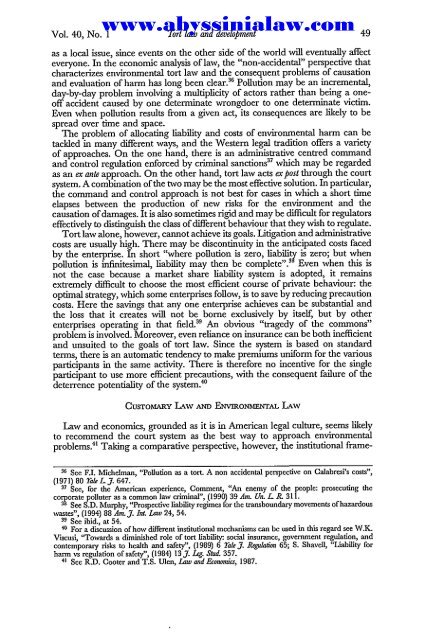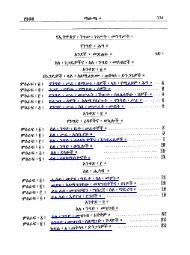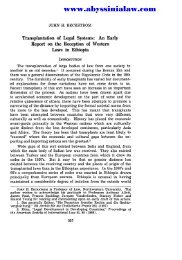Download - Abyssinia Law
Download - Abyssinia Law
Download - Abyssinia Law
You also want an ePaper? Increase the reach of your titles
YUMPU automatically turns print PDFs into web optimized ePapers that Google loves.
Vol. 40, No. I Tort law and development<br />
www.abyssinialaw.com<br />
as a local issue, since events on the other side of the world will eventually affect<br />
everyone. In the economic analysis of law, the "non-accidental" perspective that<br />
characterizes environmental tort law and the consequent problems of causation<br />
and evaluation of harm has long been clear. 36 Pollution may be an incremental,<br />
day-by-day problem involving a multiplicity of actors rather than being a oneoff<br />
accident caused by one determinate wrongdoer to one determinate victim.<br />
Even when pollution results from a given act, its consequences are likely to be<br />
spread over time and space.<br />
The problem of allocating liability and costs of environmental harm can be<br />
tackled in many different ways, and the Western legal tradition offers a variety<br />
of approaches. On the one hand, there is an administrative centred command<br />
and control regulation enforced by criminal sanctions 37 which may be regarded<br />
as an ex ante approach. On the other hand, tort law acts expost through the court<br />
system. A combination of the two may be the most effective solution. In particular,<br />
the command and control approach is not best for cases in which a short time<br />
elapses between the production of new risks for the environment and the<br />
causation of damages. It is also sometimes rigid and may be difficult for regulators<br />
effectively to distinguish the class of different behaviour that they wish to regulate.<br />
Tort law alone, however, cannot achieve its goals. Litigation and administrative<br />
costs are usually high. There may be discontinuity in the anticipated costs faced<br />
by the enterprise. In short "where pollution is zero, liability is zero; but when<br />
pollution is infinitesimal, liability may then be complete" 3 Even when this is<br />
not the case because a market share liability system is adopted, it remains<br />
extremely difficult to choose the most efficient course of private behaviour: the<br />
optimal strategy, which some enterprises follow, is to save by reducing precaution<br />
costs. Here the savings that any one enterprise achieves can be substantial and<br />
the loss that it creates will not be borne exclusively by itself, but by other<br />
enterprises operating in that field. 39 An obvious "tragedy of the commons"<br />
problem is involved. Moreover, even reliance on insurance can be both inefficient<br />
and unsuited to the goals of tort law. Since the system is based on standard<br />
terms, there is an automatic tendency to make premiums uniform for the various<br />
participants in the same activity. There is therefore no incentive for the single<br />
participant to use more efficient precautions, with the consequent failure of the<br />
deterrence potentiality of the system.'<br />
CusToMARY LAw ArN ENvmoNN=rAL LAw<br />
<strong>Law</strong> and economics, grounded as it is in American legal culture, seems likely<br />
to recommend the court system as the best way to approach environmental<br />
problems. 4 Taking a comparative perspective, however, the institutional frame-<br />
36 See F.I. Michelman, "Pollution as a tort. A non accidental perspective on Calabresi's costs",<br />
(1971) 80 T2ae L J. 647.<br />
37 See, for the American experience, Comment, "An enemy of the people: prosecuting the<br />
corporate polluter as a common law criminal", (1990) 39 Am. Un. L. R 311.<br />
See S.D. Murphy, "Prospective liability regimes for the transboundary movements of hazardous<br />
wastes", (1994) 88 Am. J. Int. <strong>Law</strong> 24, 54.<br />
39 See ibid., at 54.<br />
40 For a discussion of how different institutional mechanisms can be used in this regard see W.K.<br />
Viscusi, 'Towards a diminished role of tort liability: social insurance, government regulation, and<br />
contemporary risks to health and safety", (1989) 6 rale . Regulation 65; S. Shavell, "Liability for<br />
harm vs regulation of safety", (1984) 13 J. Leg. Stud. 357.<br />
4' See R.D. Cooter and T.S. Ulen, <strong>Law</strong> and Economics, 1987.





